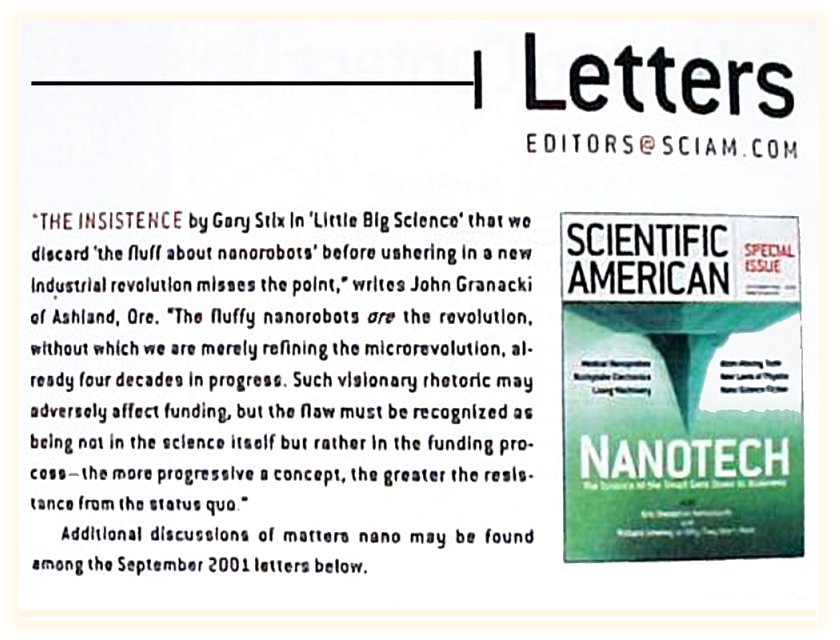 ince the primitive dawn of human industry over a million years ago,
when our
earliest upright ancestors first used their free hands to fashion tools from
rocks and sticks—and up to this present age of precision machinery,
composite materials, and integrated circuits with engineered structure at the
submicroscopic scale—our technologies have always shared one constant
factor: they have all dealt with matter in bulk quantities, manipulating clumps of
trillions, then billions, and now perhaps merely millions of atoms at a time.
Only very recently, with the advent of scanning tunneling probes and atomic
force microscopes, have singular objects been deliberately fabricated that possess only a few dozen discrete atoms, individually nudged, maneuvered or
cajoled into position per preconceived design. So far these have been primarily
objets d'art – nanoscale masterpieces produced for their own sake, as well
as to demonstrate the evolving state of the art. Very soon, however, the power
of "molecular nanotechnology" shall be unleashed, enabling the near-complete
mastery of matter on all scales from the molecular up, while bestowing upon
humankind quasi-magical powers on par with those previously attributed
only to our mythological gods! [Drexler, 1986].
ince the primitive dawn of human industry over a million years ago,
when our
earliest upright ancestors first used their free hands to fashion tools from
rocks and sticks—and up to this present age of precision machinery,
composite materials, and integrated circuits with engineered structure at the
submicroscopic scale—our technologies have always shared one constant
factor: they have all dealt with matter in bulk quantities, manipulating clumps of
trillions, then billions, and now perhaps merely millions of atoms at a time.
Only very recently, with the advent of scanning tunneling probes and atomic
force microscopes, have singular objects been deliberately fabricated that possess only a few dozen discrete atoms, individually nudged, maneuvered or
cajoled into position per preconceived design. So far these have been primarily
objets d'art – nanoscale masterpieces produced for their own sake, as well
as to demonstrate the evolving state of the art. Very soon, however, the power
of "molecular nanotechnology" shall be unleashed, enabling the near-complete
mastery of matter on all scales from the molecular up, while bestowing upon
humankind quasi-magical powers on par with those previously attributed
only to our mythological gods! [Drexler, 1986].
As of this writing, this author knows of no instance in which the bonds of individual atoms
have been thusly manipulated to produce a precise
molecular structure. Nevertheless, it is not unreasonable to anticipate this
threshold being crossed in the very near future, allowing the circumvention
of those chemical and biological processes by which aimless nature has operated
exclusively heretofore. The universe shall become humanity's toybox, its
constituent elements snapping apart and back together like tinkertoys®, to suit our every need, whim or desire! Most if not all of our current manufacturing processes
shall be rendered obsolete
– abandoned in favor of nano-precise (molecularly fine-detailed)
replication. We might see a few hold-outs at first, mainly for the purpose of
prototyping, but eventually even these should prove non-essential as more
products come to be synthesized from abstract specifications, or from pseudo-prototypes
simulated in software.
At first blush this scenario might seem absurd. Even the smallest of
practical devices are composed of billions of atoms, and we might thus suspect
that their fabrication by molecular assembly would take years. This is not true.
The nanotechnology revolution will kick into high gear as soon as the first
universal molecular assembler is built, programmed, and deployed. Additional
assemblers will then be built as that machine replicates itself. Also, it will
be a short step to the design and construction of ever smaller assemblers, each
more effecient than its predecessor. Robust demi-robotic constructions of "machine-phase matter," possessing no
more mass and volume than a bacteriophage, these "nanorobots," of which a
trillion or so might fit into a teaspoon, will be able to work together in concert as
they permeate whatever substance or object is undergoing transmogrification.
Furthermore, as miniscule as these devices may be, they shall operate on a
likewise diminished time-scale
– zipping back and forth in hops measured in
angstroms, breaking down and
building up perhaps millions of molecular bonds per second.
 Consequently, once the basic technology is established, costs will plummet
– much more dramatically than that of micro electronics. Keep in mind
that with general-purpose replication, such cost reductions will apply to
all manufactured goods. 11,025 carats of cut and polished, high-grade
diamonds (one pound) should cost about the same as a 16 ounce Pepsi ™! Larger
outlays of nanoresources should provide exponentially increased returns.
Consequently, once the basic technology is established, costs will plummet
– much more dramatically than that of micro electronics. Keep in mind
that with general-purpose replication, such cost reductions will apply to
all manufactured goods. 11,025 carats of cut and polished, high-grade
diamonds (one pound) should cost about the same as a 16 ounce Pepsi ™! Larger
outlays of nanoresources should provide exponentially increased returns.
The most notable restraint upon the fruition of our desires will probably be
the limited supplies of certain rare elements, and not necessarily the ones you
might suspect! (Ultimately, Phosphorus is likely to be the most valuable of
all.) At first we might also be plagued by harsh thermodynamic realities.
Not that we will have much trouble tapping into new energy sources, nor of
making more effecient use those we currently employ, but how we go about
channeling this energy shall certainly present our engineers with many
challenges.
Besides having the wherewithal to construct virtually anything
within the
realm of physical possibility, these "Engines of Creation" should
also be able to maintain, repair and improve upon all manners of things with
amazing effeciency. The grandest example is the human body, including the
brain. Consequently, the potential for unlimited wealth may be augmented by
unlimited health and longevity. Genetic diseases could be cured by the
straightforward expedient of correcting erroneous nucleotide sequences within
all copies of the patients DNA. Collateral damage to the phenotype—tissue
that has been misconstructed due to genetic defects or transcription errors, may
prove to be a more formidable problem, but certainly not intractable. An in
vivo fleet of personal nanobots, several trillion of them standing by,
on-call within ones tissues and bloodstream, might well be capable of patching
up even the most extreme injuries--i.e. a hail of gunfire, schrapnel, or
micrometeorites riddling ones vital organs--effecting such repairs almost as
swiftly as the damage is done, and certainly before it becomes any major
inconvenience. Curing common illnesses, healing tivial injuries, and keeping
slower degenerative processes such as aging forever in check should prove to be
relatively simple.
In more desperate
situations—such as when a person presumably "dies"— recovery and reanimation might often be instantaneous. Otherwise, a more
laborious reconstruction could be implemented on a patient who has been
cryonically preserved—vitrified within a tank of liquid nitrogen to prevent
further degradation of the pattern. As a last resort, a database which contains
the patients molecular blueprint could be accessed. From this, an otherwise
unrecoverable individual could be restored to such status was enjoyed at
whatever time the most recent back-up file was saved, or if one has "teleported"
recently, it may be possible to "reboot" from a cached copy of oneself on the
transit authority's server.
Likewise, the power of molecular nanotechnology could be employed to heal the
Earth of the the wounds which our species has inflicted upon it. Then we might
well apply this same power, augmented with new knowledge and wisdom, toward the
terraformation of other worlds!
How we choose to pursue the development of this technology is sure to provide
for a lively debate, as will how we ultimately apply it, and how we prepare ourselves,
our society, and posterity for the radical changes on the nano-horizon. In any case,
the Age of Molecular Nanotechnology and a dawning Era of Global Abundance is
nigh. Whoever pulls off the fait accompli of constructing a universal
molecular assembler will hold the keys to tomorrow.
 John Granacki
John Granacki
Umatilla, Oregon
2001
Web Resources
The Foresight Institue
The Institute for Molecular Manufacturing
Bibliography
Crandall, B. C. and Lewis, James, Editors. Nanotechnology: Research and
Perspectives. Cambridge: MIT Press, 1992.
Drexler, K. Eric. The
Engines of Creation. New York: Doubleday/Anchor, 1986. {also
available on-line}
Drexler, K. Eric. Nanosystems: Molecular Machinery, Manufacturing, and
Computation. New York: John Wiley and Sons, 1992.
Drexler, K. Eric, et al. Unbounding the Future:
The Nanotechnology Revolution. New York: Quill/William Morrow, 1991.
{also available on-line}
Fjermedal, Grant. The Tomorrow Makers: A Brave New World of Living Brain
Machines. New York: Macmillan, 1986.
Granacki, John. Letters, "Scientific American," Vol. 286, No.
1 (January, 2002): 8.
Regis, Ed. Nano: the emerging science of nanotechnology. Boston:
Little, Brown, 1995
|
|

©2001-2023
www.johngranacki.com